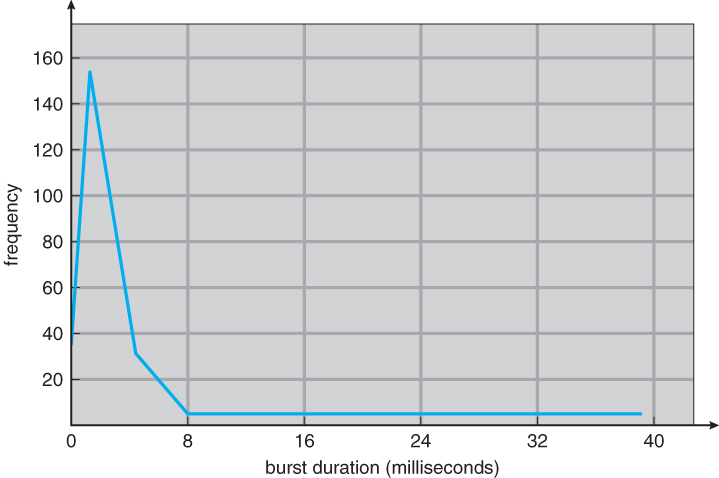[OS] CPU Scheduling - Concepts
28 Apr 2020
CPU Scheduling is to utilize CPU at most. Maximum utilization might mean:
- Schedule jobs by their priority
- Prevent starvation
- Reduce average duration for all job
CPU-I/O Burst Cycle

Process operation = CPU operation + I/O operation.
Process starts with CPU Burst. Then I/O Burst occurs, and another CPU burst ,.. and so on.
CPU burst duration time varies from systems / processes, but usually it shows exponential distribution.
I/O Bound task might have comparatively many short CPU burst. CPU Bound task might have comparatively many long CPU burst.
CPU Scheduler
Short term scheduler chooses a process in ready queue when CPU is idle.
Note that ready queue is not necessarily be FIFO queue. It can be FIFO queue, Priority Queue, Tree, or just simple linked list.
Preemptive Scheduling
Cpu Scheduling can be occurred in 4 states:
- When a process switches from the running state to the waiting state, such as for an I/O request or invocation of the wait( ) system call
- When a process switches from the running state to the ready state, for example in response to an interrupt
- When a process switches from the waiting state to the ready state, say at completion of I/O or a return from wait( )
- When a process terminates
and we divided type of scheduling as:
- Non-preemptive (Cooperative) : when scheduling occurs only in 1,4
- Preemptive : Scheduling can be occurred in any step
In non-preemptive scheduling, once one process occupies CPU , it occupies until process terminates or changes to wait state. Non-preemptive scheduling used until Windows 95.
after Window 95 / OS X uses preemptive scheduling.
In preemptive scheduling, there are two troublesome points:
- Cost over access control on shared resources when one process updating data, other process can read inconsistent data.
- System call handling
what if some process includes important kernel changes (like I/O queue) occupies CPU, while system call handles same system ? -> Most of UNIX / other OS waits for system call or I/O blocking, and operates context switch after that. (Unfortunately, this model is not adequate for real-time computing or multiprocessing. Discussed in 5.4 / 19.5)
Dispatcher
Another module for CPU scheduling is dispatcher:
- Context Switching
- Convert to User Mode
- Jump to right position of user program, for restarting program
Dispatcher call occurs every processes’ context switch call, so it has to be done asap.
Dispatch latency : old process stop time + new process start time
Criteria
Scheduling is for
- maximizing cpu utilization, throughput
- minimizing turnaround time, waiting time, response time
but researchers found in interactive system, reducing variance of requests is more important than reducing mean response time.
CPU Utilization
Keep CPU busy as possible. Theoretically, cpu usage can be 0 to 100%, but in real system, 40 to 90% is recommended.
Throughput
Completed process / time
Turnaround Time
Turnaround time =
waiting time from disk to memory
+ waiting time in ready queue
+ cpu operation time
+ i/o time
Waiting Time
Waiting time = total ready queue time. CPU scheduling only affects process’ ready queue time.
Response Time
Response time = first response started time - response submitted time
Response time does not includes output time. Total operation time is limited by output device’s time generally.
References
https://www2.cs.uic.edu/~jbell/CourseNotes/OperatingSystems/6_CPU_Scheduling.html https://brunch.co.kr/@leedongins/76